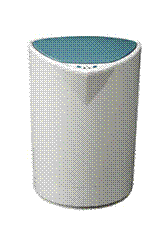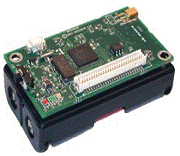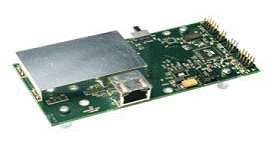


|
This is a plastic version of the NeoBin series. It features a green lid on white exterior. It comes with all accessories supplied: network adaptability (optional), touch less lid opening, LED indicators, manual opening mechanism.† Also available in different colors. |
Product Summary |
|
Price: $59.99 |
|
DESCRIPTION OF PRODUCT
Smart Trash is a system that rigs a trash can lid with an infrared depth sensor, Dz sensor, Dz mechanism, LEDís and a small wireless mote, which communicates with a base station through a mesh network. Smart Trash is a touch less can that uses the Dz sensor and Dz mechanism to open and close the lid whenever an object is within 10cm of the lid. It also uses the depth sensor to read the depth of the trash and display it using the leads. Smart trash is a garbage can made of stainless steel of about 7 feet which has a power button to switch on the sensor capability that senses the presence of an object that is within 10 cm of the lid, so as to open the can. This button is also used to call attention to the can in case of emergencies (that makes the trash can to stop working) or for disposal of garbage that have bad smell but are not full. The networking algorithm being used by Smart Trash is unique and was created to specifically balance the needs for accurate data transmission and low power consumption. The basic idea of the trash can, is that the can talk to each other and relay signals from can to can until they can be picked by the base station. The base station could be anywhere with a WIFI or internet connection. Since this application is unique, Smart Trash required the development of customized hardware and software, including an original sensing package
HARDWARE COMPONENTS MICA2 mote
Figure 1 Wireless MICA2 mote
Figure 1 is a low-power embedded wireless device that runs on a7MHz Atmel processor. It is powered by two 1.5V AA batteries and has various sleep modes to conserve battery power. Each mote has eight 10-bit analog-to-digital converter (ADCs) pins as well as eight general purpose input/output (GPIO) pins, both of which are accessible via a 51-pin connector. The wireless communication with every note as router capability operates at 868/916MHz Multi-channel radio transceiver. The measured maximum range of the MICA2 is 100m Interface Board
†††††††††††††††††††††††††††††††††††††††††††††††††††††††††††††††††††††††††††††††††††††††††††††††† †MIB600 interfaces between the motes and the Internet. This board is made up of a built-in DHCP client and a 10 Base-T connection, enabling it to acquire an IP address almost anywhere an Ethernet connection is present. A mote attached via the 51-pin connector provides the Ethernet Gateway with wireless or wired communications capabilities.
Depth Sensor
The depth sensor uses IR reflection to determine the distance to the nearest object and outputs an analog voltage inversely proportional to this distance. This sensor can reliably measure objects from 80 cm to 10 cm. The sensor is mounted on top of the lid of the trash can, facing downwards so as to measure the depth of trash in the trash can.
Power Supply The mica2 mote is powered by 2 AA 1.5V rechargeable alkaline batteries that could last for a year. To increase the operational lifetime of the system, two 3V solar cells could be connected to each trash can to trickle charge the batteries. The solar cells regulate the charging current, allowing the solar cell trickle charger to provide a variable current in proportion to the voltage of the battery. When the battery is fully charged, the trickle charging circuit provides no current, ensuring that the batteries do not overcharge. Smart Trash does not need an external power source. The trickle charging circuit provides an average of 2.5mA during the hypothetical 4 hours of usable sunlight each day. Under these conditions, Smart Trash has an operational life greater than two years. While MIB600 and the server needs line power.
NETWORKING ARCHITECTURE
Each trash can is equipped with a Depth Sensor, a MICA2 mote, which is powered by two AA batteries. The mote communicates wirelessly with the Ethernet Gateway either directly or via a mesh network of motes in other trash cans. The Ethernet Gateway is accessed by a server that runs software to parse the messages received from the motes and display the motesí status on a map. Messages are passed in two directions through the network. Sensing data is sent from the motes through the mesh network to the Ethernet Gateway, which forwards the data to the server. Requests for the system to poll its status are sent from the server through the Ethernet Gateway and propagate through the mesh network. †††††††††††† The trash can are color-coded, to indicate the position of each can. The green cans donít need emptying, but the yellow ones are nearly full, their contents within a set distance of the top. Red cans are overflowing. Employees could take the most efficient route tending to the cans, bypassing the ones that donít need emptying.
SOFTWARE The mote software runs on the TinyOS operating system, which was developed for use in limited resource network systems. It is released under the Intel Open Source License. All mote software, including TinyOS, is written in the nesC language.
The operating system of the server is Ubuntu, a distribution of GNU/Linux. The server runs Apache2 to handle web page requests and a mySQL database to store static can information. Software running on the server is written in Perl, while queries to the database are written in SQL. Various tools created to facilitate and augment intermediate testing were written in rapid application development environments such as Java.
|
|
SKU/Item Number: 2449697 |
|
Neo 3350, Aluminum Edition |

|
Home |
|
About Us |
|
Contact Us |

|
Product List |


|
Cleanliness with style... |



